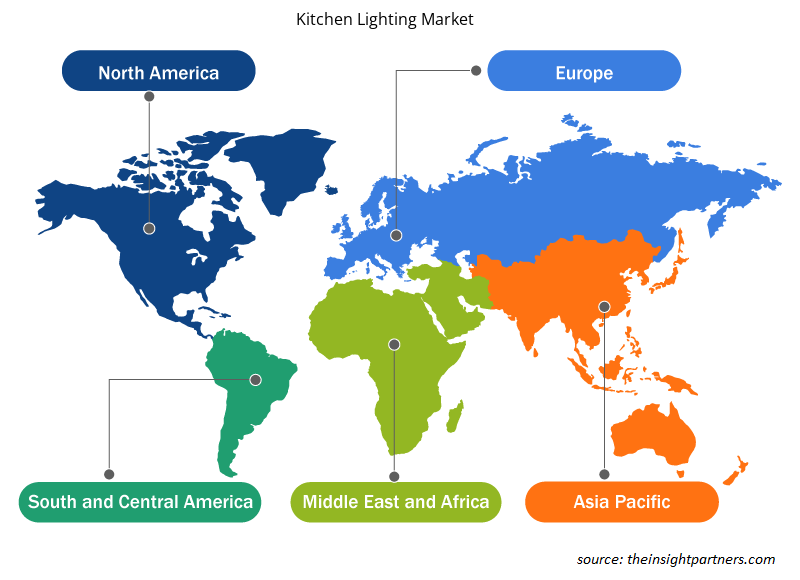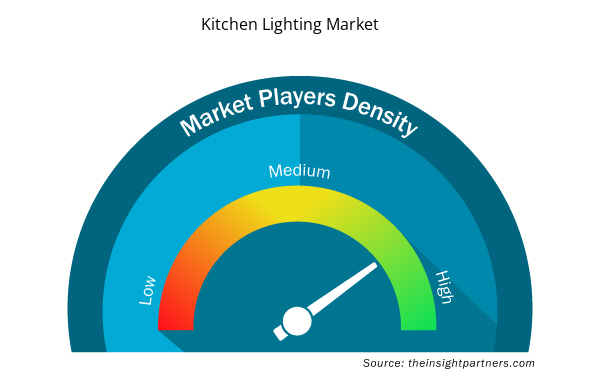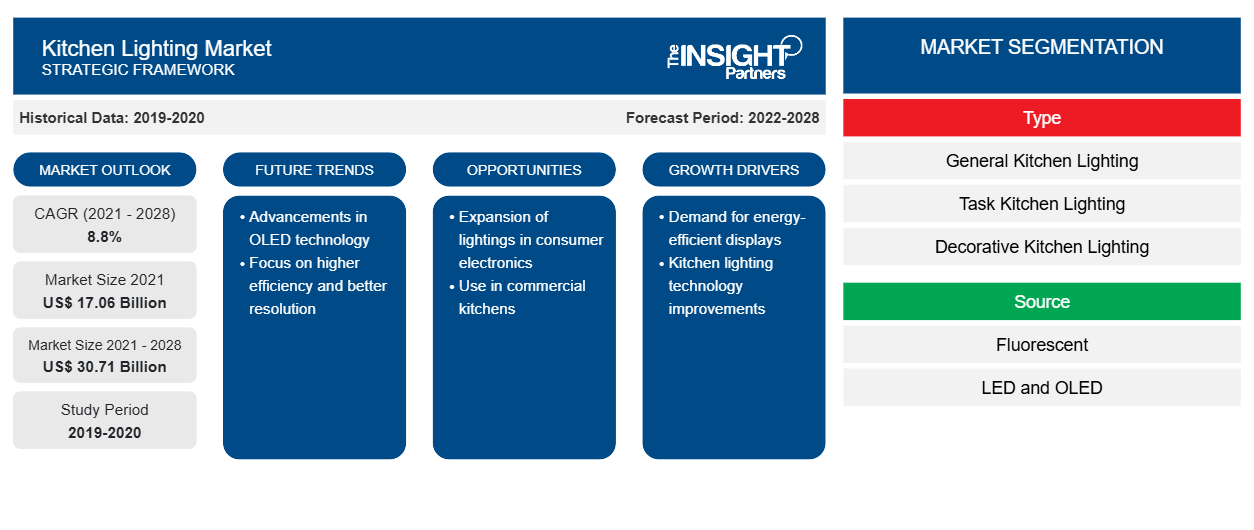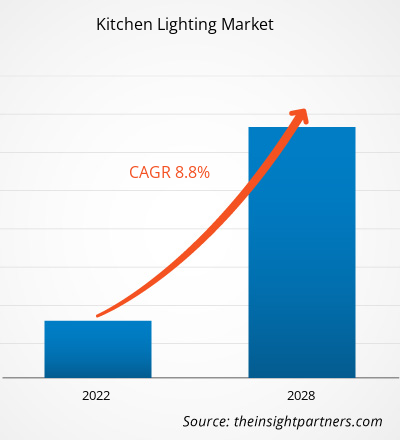キッチン照明市場は、2021年の170億5,805万米ドルから2028年には307億736万米ドルに達すると予測されており、 2021年から2028年にかけて8.8%のCAGRで成長すると推定されています。
特に北米とヨーロッパでは、政府の政策によって住宅の修理や改造活動が増加しています。改造プロジェクトにおけるキッチン改造の重要性と人気の高まりにより、キッチン照明の需要が大きく高まっています。たとえば、ハノーバーの2021年住宅改造レポートによると、米国の住宅所有者の半数以上(54%)がパンデミック中に住宅の改造を行いました。レポートによると、パンデミック中に最も人気のある住宅改造プロジェクトはキッチンとバスルームで、改造プロジェクト全体の約68%を占めていました。全米キッチン・バス協会(NKBA)のデータによると、照明は米国のキッチン改造の平均予算の0.05%を占めています。同様に、手頃な資金調達と人間中心の技術支援を組み合わせることで、すべてのヨーロッパ人にとって住宅改造をシンプルで手頃な価格で信頼できるものにすることを目的とした、欧州委員会による2018年から2021年にかけてのEuroPACEプロジェクトの開始は、ヨーロッパ全土での住宅改造活動を加速させました。さらに、白熱電球やCFL電球に代わるエネルギー効率の高い代替品としてLEDやOLED照明の人気が高まっており、照明に自然関連の要素を取り入れるなど、この地域では新しい照明コンセプトや照明デザインの需要が生まれています。上記の要因がキッチン照明市場の成長を牽引しています。
要件に合わせてレポートをカスタマイズする
このレポートの一部、国レベルの分析、Excelデータパックなど、あらゆるレポートを無料でカスタマイズできます。また、スタートアップや大学向けのお得なオファーや割引もご利用いただけます。
- このレポートの主要な市場動向を入手してください。この無料サンプルには、市場動向から見積もりや予測に至るまでのデータ分析が含まれます。
COVID-19パンデミックがキッチン照明市場に与える影響
COVID-19パンデミックは、生産停止とサプライチェーンの混乱により、キッチン照明市場に一時的に悪影響を及ぼしました。建設活動と労働者の移動に対する制限により、世界中でキッチン照明の需要が低下しました。たとえば、2020年4月から5月にかけてアイルランド政府が実施したロックダウンにより、 Mullan Lightingの工場操業が停止しました。さらに、ワクチン接種キャンペーンの実施が成功し、建設活動が再開されたことで、キッチン照明の生産、サプライチェーン、需要は改善しています。このCOVID-19のロックダウンにより、住宅の顧客や事業主は、エネルギー消費を削減するために、よりエネルギー効率の高いキッチン照明を選択するようになりました。しかし、2021年から2022年にかけて、住宅建設の増加、サプライチェーンシステムの堅牢性の向上、政府のインセンティブと政策支援により、キッチン照明市場は回復力を示しています。例えば、EU加盟国が危機からの回復プログラムの一環として改修対策に重点を置いていることで、住宅建設部門は勢いを取り戻し、 2021年から2022年にかけてパンデミック前の水準を5.7%上回ると予想されています。
キッチン照明:市場洞察
電子商取引の普及がキッチン照明市場の成長を促進
世界の多くの地域でインターネットがよりアクセスしやすくなるにつれて、eコマース業界は急速に発展しています。家電業界でのeコマースの急速な台頭により、オンラインでの製品販売が増加しています。eコマースの導入率が最も高いのは米国です。しかし、インドや中国などのアジア太平洋諸国では、照明器具のeコマースが急速に拡大しています。卸売業者は、世界のeコマース販売の大部分を管理しています(たとえば、Rexelは北米、ヨーロッパ、アジア太平洋全体で数十のeコマースサイトを運営しています)。世界的なeコマースプラットフォーム(AmazonやAlibabaなど)、専門の照明ウェブサイト(Lampenweltなど)、家具ウェブサイトを含むeテイラーは、最も急速に拡大しているセクターです( Wayfairなど)。オンラインストアを持っているメーカーはほんのわずかです。メーカー、販売業者、小売業者は、一貫性のあるパーソナライズされた顧客体験を維持しながら、オンラインで販売する新しい方法を実験しています。人工知能、音声コマース、モバイル最適化は、eコマースの人気の高まりに大きく貢献しています。キッチン照明業界のメーカー、販売業者、小売業者は、B2B eコマースの価値を理解しています。彼らは、AIを搭載したeコマースシステムを使用して、顧客が何を望んでいるかを把握し、購入するものを予測し、取引データをリアルタイムの洞察として活用して、流通と価格を改善しています。また、最近の購入と検索に基づいてカスタマイズされたエクスペリエンスを提供し、AIと推奨エンジン機能を使用して関連製品の推奨を行い、マーケティング活動を自動化することで消費者の関心を維持します。カタログまたは機能仕様、動的な価格設定と割引を通じてユーザーが製品情報を管理できるようにすることで、製品管理を簡素化します。また、多くの支払いオプションを提供し、シームレスな返品および交換プロセスを保証します。したがって、eコマース業界の急速な成長は、キッチン照明市場の需要を促進するでしょう。
キッチン照明
市場 - タイプベースの洞察
タイプに基づいて、キッチン照明市場は、一般的なキッチン照明、タスクキッチン照明、装飾キッチン照明に分類されます。一般的なキッチン照明セグメントは、2020年にキッチン照明市場で最大のシェアを占めました。人口の大多数は、キッチン照明についてあまり関心がないか、タスク照明の重要性をあまり認識していません。したがって、一般的な照明セグメントが市場を支配しています。
キッチン照明市場 - ソースベースの洞察
情報源に基づいて、世界のキッチン照明市場は蛍光灯、LED、OLEDに分類されます。LEDとOLEDセグメントは、世界的にエネルギー効率の高い照明の需要が高まっているため、2020年に最大の市場シェアを占めました。LED照明の重要性は、コスト削減の利点により、ここ数年で大幅に高まっています。
キッチン照明市場 - 製品ベースの洞察
製品に基づいて、市場はアイランドライト、ペンダントライト、天井ライト、シャンデリア、トラック照明、キャビネット下照明などに分割されています。天井ライトセグメントは2020年に最大の市場シェアを占めました。天井ライトは住宅建設に必要な照明であるため、市場を支配しています。しかし、キッチンの改造や装飾費の増加により、キャビネット下照明とペンダント照明の需要が大幅に増加しました。
キッチン照明市場で活動する企業は、市場での地位を維持するために合併や買収などの戦略を採用しています。主要企業によるいくつかの動向を以下に示します。
- 2022 年 1 月、Acuity Brands, Inc. は Microsoft との提携を発表しました。同社は Microsoft とのコラボレーションを拡大しています。この提携は、Acuity Brands のスマート照明、照明制御、ビル自動化ソリューションに役立ちます。
- 2020年5月、Cree Lightingは米国での照明ソリューションの拡大に向けてLutron Electronicsとの提携を発表しました。この提携により、Cree Lightingの屋内および屋外照明ソリューションとLutronの有線および無線デジタル器具技術が統合されます。
キッチン照明市場の地域別分析
予測期間を通じてキッチン照明市場に影響を与える地域的な傾向と要因は、Insight Partners のアナリストによって徹底的に説明されています。このセクションでは、北米、ヨーロッパ、アジア太平洋、中東、アフリカ、南米、中米にわたるキッチン照明市場のセグメントと地理についても説明します。

- キッチン照明市場の地域別データを入手
キッチン照明市場レポートの範囲
| レポート属性 | 詳細 |
|---|---|
| 2021年の市場規模 | 170.6億米ドル |
| 2028年までの市場規模 | 307億1000万米ドル |
| 世界のCAGR(2021年~2028年) | 8.8% |
| 履歴データ | 2019-2020 |
| 予測期間 | 2022-2028 |
| 対象セグメント | タイプ別
|
| 対象地域と国 | 北米
|
| 市場リーダーと主要企業プロフィール |
|
キッチン照明市場のプレーヤー密度:ビジネスダイナミクスへの影響を理解する
キッチン照明市場は、消費者の嗜好の変化、技術の進歩、製品の利点に対する認識の高まりなどの要因により、エンドユーザーの需要が高まり、急速に成長しています。需要が高まるにつれて、企業は提供品を拡大し、消費者のニーズを満たすために革新し、新たなトレンドを活用し、市場の成長をさらに促進しています。
市場プレーヤー密度とは、特定の市場または業界内で活動している企業または会社の分布を指します。これは、特定の市場スペースに、その市場規模または総市場価値に対してどれだけの競合相手 (市場プレーヤー) が存在するかを示します。
キッチン照明市場で事業を展開している主要企業は次のとおりです。
- ACUITYブランズ株式会社
- クリー照明
- オスラム・リヒトAG
- GEライティング
- パナソニック株式会社
免責事項:上記の企業は、特定の順序でランク付けされていません。

- キッチン照明市場のトップキープレーヤーの概要を入手
世界のキッチン照明市場は、タイプ、ソース、製品、および地理に基づいてセグメント化されています。タイプに基づいて、市場は一般的なキッチン照明、タスクキッチン照明、装飾的なキッチン照明に分類されます。2020年には、一般的なキッチン照明セグメントが大きな市場シェアを占めました。ソースに基づいて、キッチン照明市場は蛍光灯、LED、およびOLEDに分類されます。2020年には、LEDとOLEDセグメントが最大の市場シェアを占めました。製品に基づいて、キッチン照明市場は、アイランドライト、ペンダントライト、天井照明、シャンデリア、トラック照明、キャビネット下照明などに分類されます。2020年には、天井照明セグメントが最大の市場シェアを占めました。地理的に、キッチン照明市場は、北米、ヨーロッパ、アジア太平洋(APAC)、中東およびアフリカ(MEA)、南米(SAM)に広く分類されています。2020年には、北米が世界のキッチン照明市場で大きなシェアを占めました。
キッチン照明市場で事業を展開している大手企業としては、ACUITY Brands Inc.、Cree Lighting、OSRAM Licht AG、GE Lighting、Panasonic Corportaion、Signify Holding、Hubbell Incorporated、Kichler Lighting、Lutron Electronics、Hafele GmbH &Co などがあります。
- 過去2年間の分析、基準年、CAGRによる予測(7年間)
- PEST分析とSWOT分析
- 市場規模価値/数量 - 世界、地域、国
- 業界と競争環境
- Excel データセット



Report Coverage
Revenue forecast, Company Analysis, Industry landscape, Growth factors, and Trends

Segment Covered
This text is related
to segments covered.

Regional Scope
North America, Europe, Asia Pacific, Middle East & Africa, South & Central America

Country Scope
This text is related
to country scope.
よくある質問
Increasing proliferation of LED in Kitchen Lighting
Growing Number of Residential Construction Projects
With the continuously growing access to the internet in many regions, the e-commerce industry is flourishing rapidly. Although the US has the largest e-commerce business, the e-commerce for lighting fixtures is expanding at a high pace in India and China. Wholesalers control the majority of global e-commerce sales. Rexel operates dozens of e-commerce sites throughout North America, Europe, and Asia-Pacific. E-tailers, including the global e-commerce platforms such as Amazon and Alibaba; specialized lighting websites such as Lampenwelt; and furniture websites are the fastest expanding segments of the e-commerce business. Manufacturers, distributors, and retailers are experimenting with new ways for making online sales while maintaining a consistent and personalized client experience.
Layered Lighting, Smart Bulbs, Metallic Lights and Triple Pendant Lights, among others are latest trends that are expected in the kitchen lighting market in the coming years.
Key companies in the kitchen lighting market include Acuity Brands, Inc; Cree Inc.; Eaton Corporation; General Electric; Hubbell Lighting Inc; Kichler Lighting LLC; Lutron Electronics Co., Inc; Osram Licht AG; Panasonic Corporation; and Signify Holding.
Based on Type, the kitchen lighting market can be bifurcated into general kitchen lighting, task kitchen lighting, decorative kitchen lighting. The general kitchen lighting segment dominates the market as major adoption in developing and developed nations. The majority of the population has limited concerns about kitchen lighting or is less aware of the importance of task lighting. Thus, the general lighting segment dominates the market. However, with increasing disposable income and investment in kitchen remodeling, the task lighting and decorative lighting market are expected growth with a significant CAGR in coming years.
APAC held the largest market share in year 2020, along with the notable revenue generation opportunities in Europe and APAC.
Trends and growth analysis reports related to Electronics and Semiconductor : READ MORE..
The List of Companies - Kitchen lighting Market
- ACUITY Brands Inc.
- Cree Lighting
- OSRAM Licht AG
- GE Lighting
- Panasonic Corportaion
- Signify Holding
- Hubbell Incorporated
- Kichler Lighting
- Lutron Electronics
- Hafele GmbH &Co
The Insight Partners performs research in 4 major stages: Data Collection & Secondary Research, Primary Research, Data Analysis and Data Triangulation & Final Review.
- Data Collection and Secondary Research:
As a market research and consulting firm operating from a decade, we have published and advised several client across the globe. First step for any study will start with an assessment of currently available data and insights from existing reports. Further, historical and current market information is collected from Investor Presentations, Annual Reports, SEC Filings, etc., and other information related to company’s performance and market positioning are gathered from Paid Databases (Factiva, Hoovers, and Reuters) and various other publications available in public domain.
Several associations trade associates, technical forums, institutes, societies and organization are accessed to gain technical as well as market related insights through their publications such as research papers, blogs and press releases related to the studies are referred to get cues about the market. Further, white papers, journals, magazines, and other news articles published in last 3 years are scrutinized and analyzed to understand the current market trends.
- Primary Research:
The primarily interview analysis comprise of data obtained from industry participants interview and answers to survey questions gathered by in-house primary team.
For primary research, interviews are conducted with industry experts/CEOs/Marketing Managers/VPs/Subject Matter Experts from both demand and supply side to get a 360-degree view of the market. The primary team conducts several interviews based on the complexity of the markets to understand the various market trends and dynamics which makes research more credible and precise.
A typical research interview fulfils the following functions:
- Provides first-hand information on the market size, market trends, growth trends, competitive landscape, and outlook
- Validates and strengthens in-house secondary research findings
- Develops the analysis team’s expertise and market understanding
Primary research involves email interactions and telephone interviews for each market, category, segment, and sub-segment across geographies. The participants who typically take part in such a process include, but are not limited to:
- Industry participants: VPs, business development managers, market intelligence managers and national sales managers
- Outside experts: Valuation experts, research analysts and key opinion leaders specializing in the electronics and semiconductor industry.
Below is the breakup of our primary respondents by company, designation, and region:

Once we receive the confirmation from primary research sources or primary respondents, we finalize the base year market estimation and forecast the data as per the macroeconomic and microeconomic factors assessed during data collection.
- Data Analysis:
Once data is validated through both secondary as well as primary respondents, we finalize the market estimations by hypothesis formulation and factor analysis at regional and country level.
- Macro-Economic Factor Analysis:
We analyse macroeconomic indicators such the gross domestic product (GDP), increase in the demand for goods and services across industries, technological advancement, regional economic growth, governmental policies, the influence of COVID-19, PEST analysis, and other aspects. This analysis aids in setting benchmarks for various nations/regions and approximating market splits. Additionally, the general trend of the aforementioned components aid in determining the market's development possibilities.
- Country Level Data:
Various factors that are especially aligned to the country are taken into account to determine the market size for a certain area and country, including the presence of vendors, such as headquarters and offices, the country's GDP, demand patterns, and industry growth. To comprehend the market dynamics for the nation, a number of growth variables, inhibitors, application areas, and current market trends are researched. The aforementioned elements aid in determining the country's overall market's growth potential.
- Company Profile:
The “Table of Contents” is formulated by listing and analyzing more than 25 - 30 companies operating in the market ecosystem across geographies. However, we profile only 10 companies as a standard practice in our syndicate reports. These 10 companies comprise leading, emerging, and regional players. Nonetheless, our analysis is not restricted to the 10 listed companies, we also analyze other companies present in the market to develop a holistic view and understand the prevailing trends. The “Company Profiles” section in the report covers key facts, business description, products & services, financial information, SWOT analysis, and key developments. The financial information presented is extracted from the annual reports and official documents of the publicly listed companies. Upon collecting the information for the sections of respective companies, we verify them via various primary sources and then compile the data in respective company profiles. The company level information helps us in deriving the base number as well as in forecasting the market size.
- Developing Base Number:
Aggregation of sales statistics (2020-2022) and macro-economic factor, and other secondary and primary research insights are utilized to arrive at base number and related market shares for 2022. The data gaps are identified in this step and relevant market data is analyzed, collected from paid primary interviews or databases. On finalizing the base year market size, forecasts are developed on the basis of macro-economic, industry and market growth factors and company level analysis.
- Data Triangulation and Final Review:
The market findings and base year market size calculations are validated from supply as well as demand side. Demand side validations are based on macro-economic factor analysis and benchmarks for respective regions and countries. In case of supply side validations, revenues of major companies are estimated (in case not available) based on industry benchmark, approximate number of employees, product portfolio, and primary interviews revenues are gathered. Further revenue from target product/service segment is assessed to avoid overshooting of market statistics. In case of heavy deviations between supply and demand side values, all thes steps are repeated to achieve synchronization.
We follow an iterative model, wherein we share our research findings with Subject Matter Experts (SME’s) and Key Opinion Leaders (KOLs) until consensus view of the market is not formulated – this model negates any drastic deviation in the opinions of experts. Only validated and universally acceptable research findings are quoted in our reports.
We have important check points that we use to validate our research findings – which we call – data triangulation, where we validate the information, we generate from secondary sources with primary interviews and then we re-validate with our internal data bases and Subject matter experts. This comprehensive model enables us to deliver high quality, reliable data in shortest possible time.


 このレポートの無料サンプルを入手する
このレポートの無料サンプルを入手する